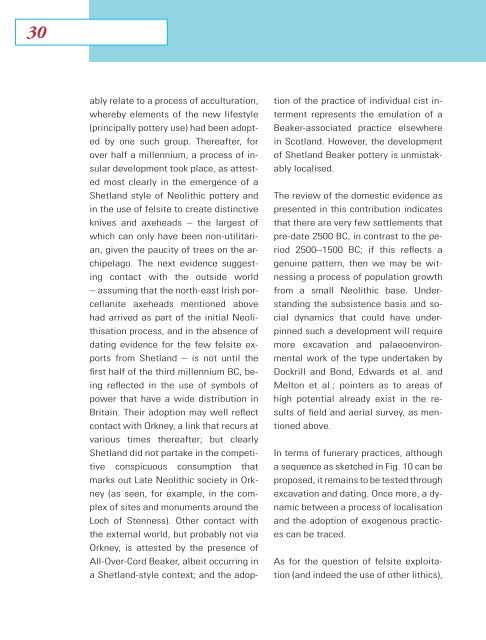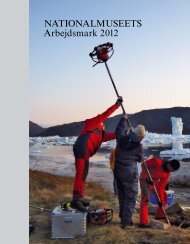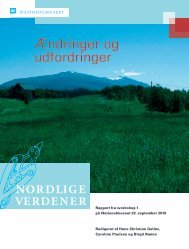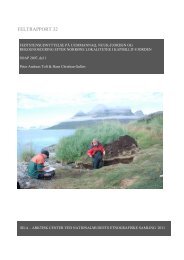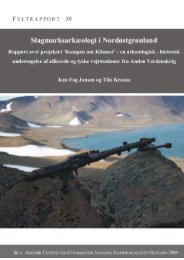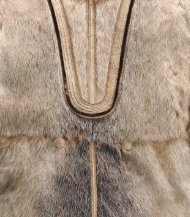The Border of Farming and the Cultural Markers - Nordlige Verdener
The Border of Farming and the Cultural Markers - Nordlige Verdener
The Border of Farming and the Cultural Markers - Nordlige Verdener
Create successful ePaper yourself
Turn your PDF publications into a flip-book with our unique Google optimized e-Paper software.
30<br />
ably relate to a process <strong>of</strong> acculturation,<br />
whereby elements <strong>of</strong> <strong>the</strong> new lifestyle<br />
(principally pottery use) had been adopted<br />
by one such group. <strong>The</strong>reafter, for<br />
over half a millennium, a process <strong>of</strong> insular<br />
development took place, as attested<br />
most clearly in <strong>the</strong> emergence <strong>of</strong> a<br />
Shetl<strong>and</strong> style <strong>of</strong> Neolithic pottery <strong>and</strong><br />
in <strong>the</strong> use <strong>of</strong> felsite to create distinctive<br />
knives <strong>and</strong> axeheads – <strong>the</strong> largest <strong>of</strong><br />
which can only have been non-utilitarian,<br />
given <strong>the</strong> paucity <strong>of</strong> trees on <strong>the</strong> archipelago.<br />
<strong>The</strong> next evidence suggesting<br />
contact with <strong>the</strong> outside world<br />
– assuming that <strong>the</strong> north-east Irish porcellanite<br />
axeheads mentioned above<br />
had arrived as part <strong>of</strong> <strong>the</strong> initial Neolithisation<br />
process, <strong>and</strong> in <strong>the</strong> absence <strong>of</strong><br />
dating evidence for <strong>the</strong> few felsite exports<br />
from Shetl<strong>and</strong> – is not until <strong>the</strong><br />
first half <strong>of</strong> <strong>the</strong> third millennium BC, being<br />
reflected in <strong>the</strong> use <strong>of</strong> symbols <strong>of</strong><br />
power that have a wide distribution in<br />
Britain. <strong>The</strong>ir adoption may well reflect<br />
contact with Orkney, a link that recurs at<br />
various times <strong>the</strong>reafter; but clearly<br />
Shetl<strong>and</strong> did not partake in <strong>the</strong> competitive<br />
conspicuous consumption that<br />
marks out Late Neolithic society in Orkney<br />
(as seen, for example, in <strong>the</strong> complex<br />
<strong>of</strong> sites <strong>and</strong> monuments around <strong>the</strong><br />
Loch <strong>of</strong> Stenness). O<strong>the</strong>r contact with<br />
<strong>the</strong> external world, but probably not via<br />
Orkney, is attested by <strong>the</strong> presence <strong>of</strong><br />
All-Over-Cord Beaker, albeit occurring in<br />
a Shetl<strong>and</strong>-style context; <strong>and</strong> <strong>the</strong> adoption<br />
<strong>of</strong> <strong>the</strong> practice <strong>of</strong> individual cist interment<br />
represents <strong>the</strong> emulation <strong>of</strong> a<br />
Beaker-associated practice elsewhere<br />
in Scotl<strong>and</strong>. However, <strong>the</strong> development<br />
<strong>of</strong> Shetl<strong>and</strong> Beaker pottery is unmistakably<br />
localised.<br />
<strong>The</strong> review <strong>of</strong> <strong>the</strong> domestic evidence as<br />
presented in this contribution indicates<br />
that <strong>the</strong>re are very few settlements that<br />
pre-date 2500 BC, in contrast to <strong>the</strong> period<br />
2500–1500 BC; if this reflects a<br />
genuine pattern, <strong>the</strong>n we may be witnessing<br />
a process <strong>of</strong> population growth<br />
from a small Neolithic base. Underst<strong>and</strong>ing<br />
<strong>the</strong> subsistence basis <strong>and</strong> social<br />
dynamics that could have underpinned<br />
such a development will require<br />
more excavation <strong>and</strong> palaeoenvironmental<br />
work <strong>of</strong> <strong>the</strong> type undertaken by<br />
Dockrill <strong>and</strong> Bond, Edwards et al. <strong>and</strong><br />
Melton et al.; pointers as to areas <strong>of</strong><br />
high potential already exist in <strong>the</strong> results<br />
<strong>of</strong> field <strong>and</strong> aerial survey, as mentioned<br />
above.<br />
In terms <strong>of</strong> funerary practices, although<br />
a sequence as sketched in Fig. 10 can be<br />
proposed, it remains to be tested through<br />
excavation <strong>and</strong> dating. Once more, a dynamic<br />
between a process <strong>of</strong> localisation<br />
<strong>and</strong> <strong>the</strong> adoption <strong>of</strong> exogenous practices<br />
can be traced.<br />
As for <strong>the</strong> question <strong>of</strong> felsite exploitation<br />
(<strong>and</strong> indeed <strong>the</strong> use <strong>of</strong> o<strong>the</strong>r lithics),


